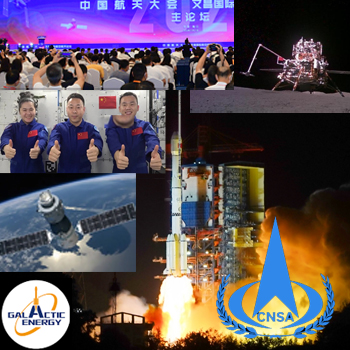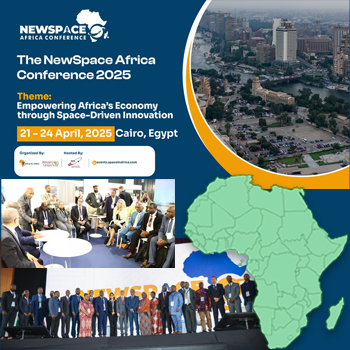China to Launch Shenzhou, Holds 2nd Lunar Samples Forum and National Space Day During China Space Conference
Tiangong Space Station Taikonauts are planning to welcome Shenzhou 20 three-member crew subsequent to their launch from Jiuquan aboard a Long March 2F rocket. Similar to the current 3-member crew, they expect a stay of about 180 days. April 22-23 will assemble scientists in Shanghai for presentation of the latest research into Moon regolith samples returned via the Chang’E-5 and Chang’E-6 missions. Also in Shanghai, Apr 23-26, ~1,200 guests from 40+ countries are expected for the China Space Conference. Goals include not only technological innovation but international cooperation and exchanges. Conference activities include forums, exhibitions, roadshows and cultural experiences. One of the forums is on Advanced Aerospace Materials, Structures and Manufacturing Technologies, and one could imaging a report on the research and development of the mag-lev launch system being accomplished in China by private aerospace company Galactic Energy, which would accelerate rockets to at least Mach 1 before ignition, saving approximately 87.54% of its fuel. Other Space Conference forums include space biology , space policy / law, and an International Forum on Commercial Space Industry. Over 400 related activities: science lectures and seminars, space knowledge competitions and the China Space Culture and Art Form will be held, particularly in celebration of April 24 as the Space Day of China, which marks the launch of its first satellite “Dongfanghong-1” on that day in 1970. (Image credits: CNSA, CMSA, CSA, CSF) |
MONDAY☆ Apr 21 — International Space Station, ~415-km LEO: Expedition 73 7-member crew is continuing vision, respiratory and circulatory system research; Anne McClain and Nichole Ayers are assembling hardware, gathering tools and preparing spacesuits for a 6.5-hour May 1 spacewalk to install a new solar array and relocate an antenna; Jonny Kim and Takuya Onishi are training for arrival of a Dragon cargo craft Apr 22. ☆ Apr 21 — Tiangong Space Station, ~390-km LEO: Shenzhou 19 Taikonaut trio, expecting Shenzhou 20 three-member crew via launch April 24 (China National Space Day), are recording video greetings for visitors to the China Pavilion at the upcoming Expo 2025 world fair in Osaka, Japan and watching turbellarians (flatworms) divided in half regenerate a full body on each half; in good physical and mental condition, Cai Xuzhe, Song Lingdong and Wang Haoze are anticipating completion of their ~170-day Shenzhou 19 mission around May 1. ★ Apr 21 — SpaceX, Launch Falcon 9 / Bandwagon 3 (Dedicated Mid-Inclination Rideshare), SLC 40, Cape Canaveral SFS FL: Dozens of micro and nanosatellites for commercial and government customers. o Apr 21-24 — African Space Agency, Egyptian Space Agency, Space in Africa, Cairo, Egypt: 4th NewSpace Africa Conference; emphasizing policy development and business prospects; African Union Commission will officially inaugurate the African Space Agency (AfSA); €250-800, at Egypt Space City. ☆ Apr 21 — Lyrids Meteor Shower Peak: Lyrids, derived from Comet C/1861 G1 Thatcher with period 415 years, are medium-swift (49 km/sec), often bright with persistent trains and can offer 15-20 per hour; best viewing in the pre-dawn hours. ☆ Apr 21 — Mercury: At westernmost elongation, 09:00. ☆ Apr 21 — Apollo Asteroid 2025 DY29: Near-Earth Flyby (0.080 AU)
|
 |
● = Terrestrial and o = International terrestrial events in local time; ☾ = Moon, ★ = Space and ☆ = International space events in Hawai’i time unless noted. |
Weekly Planet Watch – Morning Planets: Mercury(E), Venus (E), Saturn (E); Evening Planets: Mars (SW), Jupiter (W).
African Space Agency to Be Inaugurated at 4th NewSpace Africa Conference in Cairo, Egypt
The 4th NewSpace Africa Conference is being held in Cairo, Egypt on April 21-24 with theme Empowering Africa’s Economy through Space-driven Innovation and hosted by the African Space Agency (AfSA), Egyptian Space Agency, and Space in Africa. AfSA, although officially formed and ‘inaugurated’ in 2023, will again be inaugurated during the conference by the African Union (AU). There will be 65 countries represented by 500+ delegates, 50 speakers, 40 exhibitors and 35 sponsors involving space agencies, commercial companies, academia and government. Opening the Conference will be Sherif Sedky (Egyptian Space Agency CEO), Tidiane Ouattara (African Space Agency President), and Temidayo Oniosun (Space in Africa Managing Director). ‘The Future and Perspectives of the African Outer Space Programme’ Keynote is by International Space University Chancellor Valanathan Munsami. ‘Space for All: Advancing Africa’s Influence in International Space Governance’ session describes “Africa’s evolving position within the rapidly expanding global space economy, projected to reach USD 1 trillion in the coming decade.” There are 54 United Nations recognized countries in Africa–18 of them have national space agencies. Egypt, South Africa and Senegal are part of the International Lunar Research Station, while Angola, Nigeria, and Rwanda signed the Artemis Accords. Space Exploration and Research Agency, a USA company, facilitated an agreement to send the first Nigerian citizen to space aboard a future Blue Origin New Shepard flight. (Image credits: Space in Africa, et al) |
Ongoing… ☾ Jan 15 – Jun 5+ — Hakuto-R M2 Resilience, Elliptical Lunar Orbit: ispace Japan lander due on Moon June 5 at Mare Frigoris, ~60.5°N, 4.6°W; carries ~5-kg micro-rover and other payloads; launched from FL Jan 15. ☆ NET Apr — Gilmour Space, Launch Eris Block 1 / Test flight, Eris Pad, Bowen Orbital Spaceport, Queensland, Australia: First flight of 3-stage orbital rocket to deliver up to ~300 kg to LEO; first launch from Bowen Spaceport. TUESDAY☆ Apr 22 — CASC, Shanghai Spacecom Satellite Technology, Launch Long March 8 / G60 Group, Commercial LC-1, Wenchang Space Launch Site, Hainan, China: LEO satellites for planned constellation of 12,000. ● Apr 22 — Northrop Grumman, Online / Falls Church VA: Q1 2025 financial results posted prior to market opening; conference call 09:30 EDT, replays available for a limited time. ● Apr 22 — EarthLight Foundation, Online / Austin TX: EarthSpace 2025: What if space is the key to saving Earth?; webinar with co-host Rick Tumlinson, 11:00-12:30 CDT. o Apr 22-23 — Lunar Exploration and Aerospace Engineering Center of CNSA, Shanghai, China: 2nd Forum on Lunar Sample Research Results; Researchers from China report on lunar samples collected by Chang’E-5 and Chang’E-6 missions. ☆ Apr 22 — Apollo Asteroid 2025 GD1: Near-Earth Flyby (0.010 AU) WEDNESDAY● Apr 23 — NASA, CASA Moon SSERVI, et al, Online / Albuquerque NM: Planetary Sample Science Seminar, Ananya Mallik, University of Arizona, presents Insight into lunar differentiation from secondary crust formation on the Moon; 11:00 MDT.
|
o Apr 23-26 — Chinese Society of Astronautics, China Space Foundation, Shanghai, China: 2025 China Space Conference; with over 40 events including academic forums, exhibitions, science popularization and education activities.
☆ Apr 23 — Apollo Asteroid 2025 FS16: Near-Earth Flyby (0.052 AU)
THURSDAY
☆ Apr 24 — Hubble Space Telescope, LEO: Spacecraft with 2.4-meter diameter main telescope begins 36th year in space today, launched Apr 24, 1990; could continue operations until 2040s.
☆ Apr 24 — CNSA, CASC, Launch Long March 2 / Shenzhou 20, Launch Area 4 (SLS-1 / 921) Jiuquan Space Launch Center, China: Three crew members of Shenzhou 20 to launch to Tiangong Space Station for 6-month mission.
★ Apr 24 — SpaceX, Launch Falcon 9 / Starlink Group 6-74, SLC-40, Cape Canaveral SFS FL: Next batch of Starlink satellites to launch for mega-constellation.
☆ Apr 24 — Advanced Rocket Technologies, Launch Horus-4 / unknown payload, Etlaq Spaceport, Duqm, Oman: Inaugural flight of Horus-4 rocket by London-based company.
o Apr 24 — People’s Republic of China: National Day of Space Flight 2025; commemorating the launch of China’s first satellite, Dongfanghong-1 on April 24, 1970.
● Apr 24 — Ad Astra Kansas Day: Initiated in 2003 to promote public awareness of the importance of science & technology to Kansas’ growth; marked for the day of Hubble Space Telescope launch, released by Kansas Astronaut Steve Hawley from Space Shuttle Discovery robotic arm.
☾ Apr 24 — Moon: 2.02° NNW of Saturn, 17:00; 2.12° SE of Venus, 18:00; 1.64° NNW of Neptune, 23:00.
☆ Apr 24 — Aten Asteroid 2019 FY2: Near-Earth Flyby (0.032 AU)
FRIDAY
★ Apr 25 — SpaceX, Launch Falcon 9 / Starlink Group 11-9, SLC-4E, Vandenberg SFB CA: Batch of satellites for Starlink mega-constellation space-based Internet communication system; launch window open 14:40-19:11 PDT.
● Apr 25 — Universities Space Research Association, Online / Laurel MD: Abstracts due for meeting Progress in Understanding the Pluto System: 10 Years after Flyby; to be held Jul 14-18 at Johns Hopkins University Applied Physics Laboratory.
o Apr 25-29 — Starmus, Instituto Astrofisica Canarias, Government of Spain, et al, La Palma, Canary Islands, Spain: Starmus 2025: The Island of The Stars; with 45+ keynote lectures, 2 camps of science and concerts, “stars” + “music”.
☾ Apr 25 — Moon: Within circle of diameter 4.86° with Venus and Neptune, 00:00; 3.9° NNW of Mercury, 12:00.
☆ Apr 25 — Apollo Asteroid 462959 (2011 DU): Near-Earth Flyby (0.032 AU)
SATURDAY
● Apr 26 — NASA, CASA Moon SSERVI, et al, Online / Albuquerque NM: Planetary Sample Science Seminar, Thomas Orlando and Alisha Vira of Georgia Tech present Nanoscale characterization of Apollo lunar samples; 11:00 MDT.
● Apr 26 — American Institute of Aeronautics & Astronautics, Los Angeles Section, Lomita CA: Daniel Adamo presents Spanning The Earth/Mars Chasm With Interplanetary Synodic-Resonant Waypoints; 10:30-12:30 PDT.
● Apr 26 — American Institute of Aeronautics & Astronautics, Los Angeles Section, Lomita CA: Center for Employment Opportunities presents Second Chance Month: A New Frontier, the LA Fair Chance Ordinance; 12:30-13:00 PDT.
● Apr 26 — American Institute of Aeronautics & Astronautics, Los Angeles Section, Planetary Sunshade Foundation, Lomita CA: Jeff Overbeek and Marty Bradley present Aerospace Engineering to Cool the Earth; 13:00-14:40 PDT.
☆ Apr 26 — Apollo Asteroid 2015 XF352: Near-Earth Flyby (0.069 AU)
SUNDAY
★ Apr 27 — Firefly Aerospace, Launch Firefly Alpha / FLTA006 (Message in a Booster), SLC-2W, Vandenberg SFB CA: 6th Alpha launch takes Lockheed Martin LM400 satellite bus for communications payloads.
o Apr 27-29 — European Interparliamentary Space Conference (EISC), European Space Policy Institute, Tartu, Estonia: EISC 2025: Security in Space: Europe’s Challenges and Opportunities.
o Apr 27 – May 2 — European Geoscience Union, Vienna, Austria: EGU General Assembly; includes sub-programs on Moon and Solar System planets.
☾ Apr 27 — Moon: At perigee, distance 357,113 km, 06:13; New Moon, 09:32.

